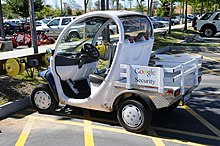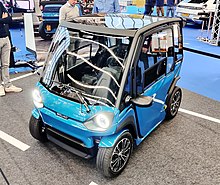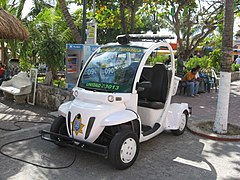 GEM on duty as security car at Googleplex, Mountain View, California
GEM on duty as security car at Googleplex, Mountain View, California Renault Twizy heavy quadricycle in downtown Rome.
Renault Twizy heavy quadricycle in downtown Rome.
A neighborhood electric vehicle (NEV) is an American category for battery electric vehicles that are usually built to have a top speed of 25 miles per hour (40 km/h), and have a maximum loaded weight of 3,000 lb (1,400 kg). Depending on the particular laws of the state, they are legally limited to roads with posted speed limits of 35 miles per hour (56 km/h) or less (in some states 45 mph or less). NEVs fall under the United States Department of Transportation classification for low-speed vehicles. The non-electric version of the neighborhood electric vehicle is the motorized quadricycle.
An NEV battery pack recharges by plugging into a standard outlet and because it is an all-electric vehicle it does not produce tailpipe emissions. In the state of California NEVs are classified by the California Air Resources Board (CARB) as zero-emissions vehicles (ZEV) and are eligible for a purchase rebate of up to $1,500 if purchased or leased on or after March 15, 2010.
As of June 2014, the GEM neighborhood electric vehicle was the market leader in North America, with global sales of more than 50,000 units since 1998. Another top selling NEV is the Renault Twizy, launched in March 2012, it was the top-selling plug-in electric vehicle in Europe during 2012, and the heavy quadricycle has sold almost 22,000 units through December 2018.
Sales of low-speed small electric cars (LSEVs) experienced considerable growth in China between 2012 and 2015 due to their affordability and flexibility. A total of 200,000 low-speed small electric cars were sold in China in 2013, most of which are powered by lead-acid batteries. In 2015, sales rose to 750,000 units, and to 1.2 million in 2016. As of December 2016, the stock of LSEVs was estimated to be between 3 million and 4 million units. About 1.4 million low-speed electric vehicles were sold in 2018.
U.S. regulations

Low-speed vehicle is a federally approved street-legal vehicle classification which came into existence in 1998 under Federal Motor Vehicle Safety Standard 500 (FMVSS 500). There is nothing in the federal regulations specifically pertaining to the powertrain.
Low-speed vehicles are defined as a four-wheeled motor vehicle that has a gross vehicle weight rating of less than 3,000 pounds (1,400 kg) and a top speed of between 20 and 25 mph (32 and 40 km/h). Those states that authorize NEVs generally restrict their operation to streets with a maximum speed limit of 35 or 45 mph (56 or 72 km/h). Because of federal law, car dealers cannot legally sell the vehicles to go faster than 25 mph (40 km/h), but the buyer can easily modify the car to go 35 mph (56 km/h). However, if modified to exceed 25 mph (40 km/h), the vehicle then becomes subject to safety requirements of passenger cars.
These speed restrictions, combined with a typical driving range of 30 miles (48 km) per charge and a typical three-year battery durability, are required because of a lack of federally mandated safety equipment and features which NEVs cannot accommodate because of their design. To satisfy federal safety requirements for manufacturers, NEVs must be equipped with three-point seat belts or a lap belt, running lights, headlights, brake lights, reflectors, rear view mirrors, and turn signals. Windshield wipers are not required. In many cases, doors may be optional, crash protection from other vehicles is partially met compared to other non-motorized transport such as bicycles because of the use of seat belts.
State regulations

Regulations for operating an NEV vary by state. The federal government allows state and local governments to add additional safety requirements beyond those of Title 49 Part 571.500. For instance, the State of New York requires additional safety equipment to include windshield wipers, window defroster, speedometer, odometer and a back-up light. Generally, they must be titled and registered, and the driver must be licensed. Because airbags are not required the NEV cannot normally travel on highways or freeways.
NEVs in many states are restricted to roads with a speed limit of 35 mph (56 km/h) or less. As of February 2012, NEVs are street-legal in 46 states. In Ohio, NEVs are classified as "low-speed vehicles", as opposed to golf carts, which are "under-speed vehicles".
Community design


Some communities are designed to separate neighborhoods from commercial and other areas, connecting them with relatively high speed thoroughfares on which NEVs cannot go, legally or safely. As a result, these vehicles are most common in communities that provide separate routes for them or generally accommodate slow speed traffic.
Communities designed specifically with NEVs and similarly sized vehicles in mind include:
- Avalon, California
- Celebration, Florida
- Lady Lake, Florida
- The Villages, Florida
- Peachtree City, Georgia
Other cities and communities that have adopted NEV-friendly ordinances or have experienced a significant increase of them and street-legal golf cars since 1990 include:
- Alameda, California
- Put-in-Bay, Ohio
- Venice Beach, Los Angeles, California
- Lincoln, California
- Palm Desert, California
- Sun City, Arizona
- Charleston, South Carolina
- Myrtle Beach, South Carolina
- Coronado, California
- Dunedin, Florida
Sales
- US and Europe

As of July 2006, there were between 60,000 and 76,000 low-speed battery-powered vehicles in use in the United States, up from about 56,000 in 2004. Pike Research estimated there were 478,771 NEVs on the world roads in 2011. The two largest NEV markets in 2011 were the United States, with 14,737 units sold, and France, with 2,231 units.
The different variants of the REVAi, available in 26 countries, sold about 4,600 vehicles worldwide by late 2013, with India and the UK as the main markets. As of October 2015, the GEM neighborhood electric vehicle was the market leader in North America, with global sales of more than 50,000 units since 1998. Another top selling NEV is the Renault Twizy heavy quadricycle, launched in March 2012, with global sales of 15,000 units through April 2015. The Twizy was the top-selling plug-in electric vehicle in Europe during 2012. As of December 2016, a total of 18,592 units had been sold in Europe, representing 96.1% of global sales. Global sales since inception totaled 21,874 units through December 2018.
- China

Sales of low-speed small electric cars experienced considerable growth in China between 2012 and 2015 due to their affordability and flexibility because they can be driven without a driver license. Most of these small electric cars are popular in small cities, but they are expanding to larger cities. A total of 200,000 low-speed small electric cars were sold in China in 2013, most of which are powered by lead-acid batteries. These electric vehicles not considered by the government as new energy vehicles due to safety and environmental concerns, and consequently, do not enjoy the same purchase benefits as highway legal plug-in electric cars.
In 2015, sales of low-speed small electric passenger vehicles in China totaled 750,000 units, and 1.2 million in 2016. As of December 2016, the stock of low-speed small electric car was estimated to be between 3 million and 4 million units. However the sales ratio between LSEVs and passenger NEVs began to decrease beginning in 2015. In 2014, LSEVs sales were 15 times more than normal plug-in passenger cars, but the ratio declined to about four times in 2016, and fell to 2.5 times in 2018, when about 1.1 million normal passenger electric vehicles, compared to 1.4 million low-speed vehicles.
Examples
- Bombardier Class E
- BugE
- Citroën Ami
- CT&T
- Estrima Birò
- Global Electric Motorcars (GEM)
- The Kurrent
- Ligier EZ-10 EasyMile
- Mia electric
- Might-E Truck
- Miles Automotive Group
- MIT Car
- Moke America eMoke
- Personal Urban Mobility and Accessibility (proposed)
- Polaris Ranger EV LSV
- Renault Twizy
- REVAi
- SC Carts
- Squad Solar
- Trikke Trikke Pon-e 48v UPT
- Xtreme Green Products
- XEV Yoyo
- ZAP Xebra Zap Xebra (2006 - 2010)(Models SD & Truck)
- ZENN (Feel Good Cars)
Gallery
-
 A GEM e2 used by the Tourist Police in Playa del Carmen, Mexico, being recharged
A GEM e2 used by the Tourist Police in Playa del Carmen, Mexico, being recharged
-
 Might-E Truck from Canadian Electric Vehicles
Might-E Truck from Canadian Electric Vehicles
-
NEV from Dynasty IT
-
 CITY4 from SC Carts
CITY4 from SC Carts
-
 2019 Moke America eMoke, front left (Amagansett)
2019 Moke America eMoke, front left (Amagansett)
See also
- City car
- Government incentives for plug-in electric vehicles
- Medium Speed Vehicle
- Quadricycle (EU vehicle classification) – EU vehicle category for four-wheeled microcars
- Solar Golf Cart
- Electric Commercial Vehicles
- Electric rickshaw
References
- "What is a neighborhood electric vehicle (NEV)?". AutoblogGreen. 2009-02-06. Retrieved 2010-06-09.
- "US DEPARTMENT OF TRANSPORTATION National Highway Traffic Safety Administration 49 CFR Part 571 Federal Motor Vehicle Safety Standards". Retrieved 2009-08-06.
- "CVRP Eligible Vehicles". Center for Sustainable Energy California. Archived from the original on 2013-07-29. Retrieved 2010-06-08.
- "Clean Vehicle Rebate Project". Center for Sustainable Energy. Archived from the original on 2010-04-02. Retrieved 2010-04-01.
- ^ Stephen Edelstein (2015-11-03). "Polaris Updates GEM Low-Speed Electric Vehicles". Green Car Reports. Retrieved 2015-11-22.
- ^ Groupe Renault (January 2017). "Ventes Mensuelles" [Monthly Sales] (in French). Renault.com. Retrieved 2017-01-19. Click on "(décembre 2016)" to download the file "XLSX - 239 Ko" for CYTD sales in 2016, and open the tab "TWIZY RENAULT".
- ^ Groupe Renault (January 2019). "Ventes Mensuelles - Statistiques commerciales mensuelles du groupe Renault" [Monthly Sales - Monthly sales statistics of the Renault Group] (in French). Renault.com. Retrieved 2019-02-12. Sales figures includes passenger and light utility variants. Click on link "XLSX - 142 Ko Ventes mensuelles du Groupe (Décembre 2018)" to download the file, and open the tab "Sales by Model" to access sales figures for 2017 and 2018.
- ^ International Energy Agency (IEA), Clean Energy Ministerial, and Electric Vehicles Initiative (EVI) (May 2016). "Global EV Outlook 2016: Beyond one million electric cars" (PDF). IEA Publications. Archived from the original (PDF) on 2016-08-24. Retrieved 2016-08-24.
{{cite web}}: CS1 maint: multiple names: authors list (link) See pp. 24-25. - ^ Jiang Xueqing (2014-01-11). "New-energy vehicles 'turning the corner'". China Daily. Retrieved 2014-01-12.
- ^ Bullard, Nathaniel; McKerracher, Colin (2019-02-08). "Dispelling the Myths of China's EV Market". Bloomberg L.P. Retrieved 2019-02-09.
- ^ International Energy Agency (IEA), Clean Energy Ministerial, and Electric Vehicles Initiative (EVI) (June 2017). "Global EV Outlook 2017: Two million and counting" (PDF). IEA Publications. Archived from the original (PDF) on 2017-06-07. Retrieved 2018-02-01.
{{cite web}}: CS1 maint: multiple names: authors list (link) See pp. 5–7, 12–22, 27–28, and Statistical annex, pp. 49–51. - 49 CFR § 571.3 - US Code of Federal Regulations Archived 2009-05-05 at the Wayback Machine; "FMCSA - Regulation: 571.500". Archived from the original on 2008-10-18. Retrieved 2008-07-18.
- "Pennsylvania may make neighborhood-electric vehicles street legalauthor=Danny King". Autoblog Green. 2012-02-06. Retrieved 2012-02-10.
- Ohio Rev. Code §4501.01. "Motor vehicles definitions".
- Zúñiga, Janine (2007-05-29). "Coronado's electric cars enjoying life in the fast lane". San Diego Union-Tribune. Retrieved 2007-08-24.
- Saranow, Jennifer (27 July 2006), "The Electric Car Gets Some Muscle", Pittsburgh Post-Gazette, retrieved 2009-04-24
- ^ Dave Hurst; Clint Wheelock (2011). "Executive Summary: Neighborhood Electric Vehicles - Low Speed Electric Vehicles for Consumer and Fleet Markets" (PDF). Pike Research. Archived from the original (PDF) on 2013-05-17. Retrieved 2012-02-05.
- Danny King (2011-06-20). "Neighborhood Electric Vehicle Sales To Climb". Edmunds.com Auto Observer. Archived from the original on 2012-05-27. Retrieved 2012-02-05.
- Alysha Webb (2013-12-23). "Indian EVs Await Government Support, But Some Owners Are Already Happy With Their Cars". PluginCars.com. Retrieved 2013-12-24.
- "Mahindra REVA: Petrol-free REVA". Reva Electric Car Company. Archived from the original on 2012-02-15. Retrieved 2012-02-25.
- "15,000 Renault Twizy Now in Circulation". AutoVolt magazine. 2015-04-01. Retrieved 2015-11-22.
- Association pour l'Avenir du Véhicule Electrique Méditerranéen (AVEM) (2012-06-27). "L'étonnant succès du Renault Twizy en Allemagne" [The surprising success of the Renault Twizy in Germany] (in French). Moteur Nature. Retrieved 2012-07-27.
- "2011 Polaris RANGER EV Electric UTV : Overview". Polarisindustries.com. Retrieved 2010-11-27.
- "Xtreme Green 100% Electric Vehicles". Xtreme Green.
- Are tiny electric cars the answer to big city pollution problems?
External links
- The ZENN (Zero Emissions No Noise) of Driving
- S.A.V.E. pushes legislation for 35 mph in Montana
- Yahoo! NEVs group
- Summary of Montana's Medium-Speed Electric Vehicle (MSEV) legislation
- Washington's MSEV legislation